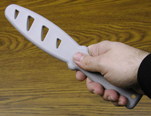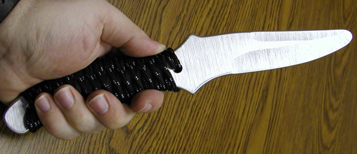its paid sponsors, whose products you need!
“Stay ‘unreasonable.’ If you
don’t like the solutions [available to you], come up with your
own.”
Dan Webre
The Martialist does not
constitute legal advice. It is for ENTERTAINMENT
PURPOSES ONLY.
Copyright © 2003-2004 Phil Elmore, all rights
reserved.
The Continuum of Training Blades
By Phil Elmore
WARNING: Knife training is an inherently dangerous activity. Take these suggestions
at your own risk.The Martialist
disclaims any liability resulting
from injuries sustained while training using these ideas.
 Knife fighting is a very important skill, the knowledge of
Knife fighting is a very important skill, the knowledge of
which will benefit any martial artist and fighter. We are fortunate
to live at a time when many different training tools are available for
those dedicated to learning and mastering such talents. Training
knives of rubber, plastic, wood, and metal are readily available on
today’s market, but each has a role to which it is best suited.
Soft
rubber training knives are the only knives I advocate for active
sparring (with the exception of
No
Lie marking blades, which are specifically designed for this purpose).
Proper knife sparring requires a degree of energy and speed that makes
rigid knives unsafe for this activity. A rigid blade to the throat
or even the abdomen or groin can cause significant injury. (It goes
without saying that eye protection is a must during active knife
sparring.) There are some rigid rubber knives on the market that are
safer than plastic, wood, or metal trainers, but the more rigid the knife,
the more critical eye protection becomes.

Cold Steel rigid rubber training knife.
It is semi-flexible.
 Plastic
Plastic
knives are a good compromise for safety where active sparring is not
an issue, such as training knife disarms and defenses. Light but
strong, such blades have the rigidity necessary to make disarms practical,
but present little danger of injury while practicing counters and
evasions. The lighter weight of plastic training tools also makes
them less dangerous as flying objects on those occasions when a “knife” is
sent airborne during practice.
Wooden training knives are not flexible and lack
the benefits of both plastic knives (lighter weight and rounded
surfaces) and metal knives (realistic appearance). Wooden weapons
are potentially lethal (and often have points much sharper than one would
prefer, though some sandpaper and a file can remedy this). I own no
wooden training knives, though I do have a bokken (wooden training
katana).

Edges2 aluminum trainer.
This “knife” could still hurt you.
Metal trainers are the best tools for realistic
knife practice. I do not advocate them for active sparring because
they are rigid (and as strong as metal, obviously) and thus potentially
very unsafe when facing another person. They are, however, the best
tools available for training forms and the mechanics of knife fighting,
realistic disarm and evasion training, solo practice drills, and related
activities.
Train safely and choose your tools properly
for the activities in which you engage.
Your eyesight — and your
life — are too important to do otherwise.
